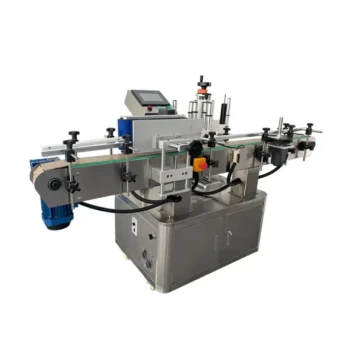At their core, the caster wheels on a honey stick machine serve two fundamental purposes. They provide critical mobility for positioning and cleaning, and essential structural support for the machine's considerable weight. This transforms a heavy piece of industrial equipment into a flexible asset that can be easily integrated into a production line.
While the immediate function of caster wheels is mobility, their true value lies in operational flexibility. They make a complex machine easy to reposition, clean, and maintain—all critical factors in any efficient and compliant food production environment.
The Role of Mobility in a Production Environment
A honey stick machine is a complex piece of equipment with many integrated parts, such as a honey hopper, film rollers, and motors. Its ability to be moved easily is not a minor convenience; it is a significant operational advantage.
Facilitating Flexible Layouts
Production needs change. The caster wheels allow you to reconfigure a packaging line or move the machine to a different area without requiring specialized equipment like a forklift.
Simplifying Cleaning and Maintenance
In food processing, hygiene is paramount. Wheels allow staff to move the machine away from walls and other equipment to access all sides for thorough cleaning and routine maintenance, ensuring food safety standards are met.
Ease of Installation and Relocation
Casters make the initial setup of the machine much simpler. They also provide a significant advantage if the equipment ever needs to be moved to a new facility.
Providing Essential Structural Support
The wheels are not just for movement; they are an integral part of the machine's structural foundation. They are engineered to handle the static and dynamic loads of the entire system.
Supporting the Machine's Components
A honey stick machine carries significant weight. This includes the heavy-duty motor, a honey hopper filled with product, and the entire assembly of rollers and sealing bars. The casters are designed to bear this combined load safely.
Ensuring Stability During Operation
The machine's motor drives moving parts like the film rollers and the cutter, which can create vibrations. The casters, which almost always include locking mechanisms, provide a stable base that prevents the machine from shifting during operation, ensuring a clean, consistent cut and seal.
Distributing Weight Evenly
The placement of the casters is engineered to distribute the machine's total weight evenly across its frame. This prevents stress on any single point and protects both the machine and the production floor from damage.
Understanding the Trade-offs
While highly beneficial, relying on caster wheels comes with practical considerations that every operator should be aware of.
The Need for Locking Mechanisms
The most critical feature of industrial casters is a reliable locking mechanism. Failure to lock the wheels during operation can lead to dangerous shifting, potentially causing product defects, equipment damage, or injury.
Floor Condition Requirements
Caster wheels perform best on smooth, level concrete floors common in production facilities. Significant cracks, slopes, or uneven surfaces can make moving the machine difficult and may compromise its stability even when locked.
Vibration Transmission
Compared to solid leveling feet bolted to the floor, caster wheels can transmit more vibration from the floor to the machine, and vice-versa. For most honey stick operations this is not an issue, but it is a factor in extremely high-precision packaging environments.
Making the Right Choice for Your Goal
Considering the function of casters helps you evaluate a machine based on your specific operational needs.
- If your primary focus is a dynamic production floor: Prioritize robust, smooth-rolling casters with easy-to-use locking mechanisms that allow for rapid reconfiguration.
- If your primary focus is a permanent, high-volume line: Look for machines that offer both casters for initial placement and heavy-duty leveling feet for maximum long-term stability.
- If your primary focus is maintenance and serviceability: Ensure the casters provide enough clearance and mobility to easily access key components like the motor and sealing systems.
Ultimately, the humble caster wheel is a key feature that enables the efficiency, safety, and adaptability of a modern honey stick machine.
Summary Table:
| Purpose | Key Benefits | Key Considerations |
|---|---|---|
| Mobility | Flexible layout changes, easy cleaning, simple installation/relocation. | Requires reliable locking mechanisms for safety. |
| Structural Support | Supports heavy components (motor, hopper), ensures operational stability, distributes weight evenly. | Best on smooth, level floors; may transmit more vibration than fixed feet. |
Ready to optimize your honey packaging line with the right equipment?
At HONESTBEE, we supply durable, high-performance beekeeping supplies and equipment—including honey stick machines designed for commercial apiaries and distributors. Our wholesale-focused operations ensure you get the robust solutions you need for a flexible, efficient, and safe production environment.
Contact us today to discuss your specific needs and discover how our equipment can enhance your operation's productivity and compliance!
Related Products
- Automatic Honey Filling and Filtering Machine for Beekeeping Bottle Filling
- 10L Stainless Steel Electric Honey Press Machine
- Precision Durable Efficient HONESTBEE Rotary Honey Filling Machine
- Modern Honeycomb Pattern Wooden Honey Dipper for Stirring and Drizzling
- Natural Wood Honey Dipper for Tea Coffee and Desserts
People Also Ask
- What bottling equipment is used after honey filtering? Choose the Right System for Your Scale
- What factors should be considered when choosing between semi-automatic and automatic honey filling machines? Optimize Your Honey Production Line
- How long to leave honey to settle before bottling? Achieve Perfect Clarity in 48 Hours
- How can the durability of a honey filling machine be assessed? 3 Key Factors for Long-Lasting Performance
- How does a honey filling machine ensure hygiene? Maintain Purity & Quality in Your Honey



















